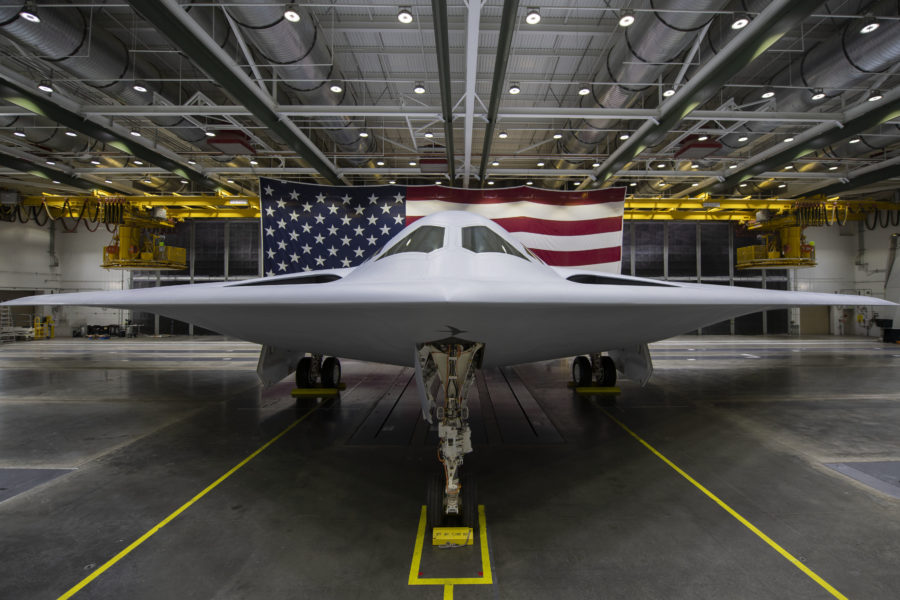The B-21 program is on schedule and remains below government unit cost estimates, but inflation threatens its profitability for Northrop Grumman, company leaders said on their quarterly earnings call. The program is also set to enter low-rate initial production, a phase it will likely remain in for the rest of the decade, they said.
“We continue to perform well on the program and remain on track for first flight later this year,” Northrop president, chair, and chief executive officer Kathy Warden said on the Jan. 26 call. The first B-21 rolled out of Northrop’s Palmdale, Calif. plant in December 2022.
But “as the program transitions into low rate initial production [LRIP], we are working to address macroeconomic conditions, especially related to inflation and their impact on materiel suppliers and labor,” Warden said. The first LRIP contract should be awarded this year, she added.
Chief Financial Officer Dave Keffer added that the company expects the program to have 10-to-20 basis point (0.1-0.2 percent) impact in 2023, when the “first of five LRIP” contracts are expected. Those five contracts are “scheduled to run through approximately the end of the decade.”
More immediately, the program has felt the impact of inflation.
“Given that this contract was initially awarded in 2015, the recent and really unprecedented … impact of inflation, labor, [and] supply chain disruptions, have affected the cost estimate” at completion, Warden said.
The Air Force has not yet “exercised any of the LRIP options. So like we do on any priced options, we continue to look at what the future may hold and reflect that in our estimates at [completion], but those are indeed estimates of costs and future performance,” Warden said.
While Northrop doesn’t expect a loss on LRIP “to be probable, if it were ultimately to occur, it would spread over all five lots of the program and … that’s important related to any cashflow impact,” she said.
Although the program is concluding the engineering and manufacturing development phase, some EMD activities will continue for several years, Warden said. However, LRIP is under a fixed-price agreement, so inflation could adversely affect the program’s profitability.
“Importantly, I want to highlight that our B-21 unit cost projections remain below the government’s independent cost estimate,” she said. “The program has strong support from the U.S. Air Force, Congress, and our suppliers,” and the Air Force continues to say it expects to buy “at least 100” of the aircraft.
The first LRIP contract will not be a “triggering event” for any programmatic adjustments, Keffer said, but it’s likely Northrop will adjust its forecasts at that point.
Keffer also indicated that Northrop got a $66 million performance incentive payment on the last part of the B-21’s EMD phase, and this is an indication of future performance and “future incentives in that phase.”
Warden and Keffer both said Northrop is “working with” the government on inflation adjustments for future work and to “enhance efficiencies” in the B-21 program. However, “we do not believe that a loss on the LRIP phase is probable and therefore no such loss is reflected in our … guidance,” Keffer said, although he later added a loss is “possible” if economic conditions worsen.
Warden said the prospects of a full-year continuing resolution or national default are also background threats to company profits, but she expects that recent plus-ups in the defense budget are likely to either stay in place or increase.
Warden said the enthusiasm for fixed-price contracts is waning fast both in industry and government, though.
The government is “engaging in conversations with industry, to understand ways to motivate our investment in future capability and capacity. That is what they really want,” she said. The government now understands that “shifting too much risk to industry doesn’t support that investment, nor does it deliver the capability they need in a timely fashion. So with that, I suspect we’re going to see less fixed-price development going forward.”
With regard to inflation, “the industry broadly is pushing back on accepting long term fixed-price contracts right now. And they’re asking for ‘re-openers’ for inflation,” Warden said, meaning re-negotiation of terms.
“We expect that to continue and as our suppliers ask us for that, we of course, are passing that on to the government. And really, that’s just common sense. So I believe that will become the norm.”
Warden said Northrop is competing well for talent, buoyed by press coverage of its James Webb Space Telescope and the B-21, which have “heightened the interest” of qualified people to work for the company. However, labor shortages are a chronic problem for the industry, she said. Northrop’s ability to fill jobs has helped it win more contracts than it expected to, particularly in the area of space and space launch, Warden said.
The aeronautics sector other than B-21 declined slightly with the winding-down of the E-8 JSTARS and RQ-4 Global Hawk program, and the ”flatness” of the F-35 program, on which Northrop is a main subcontractor, Warden acknowledged.

